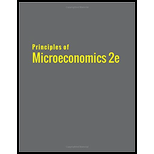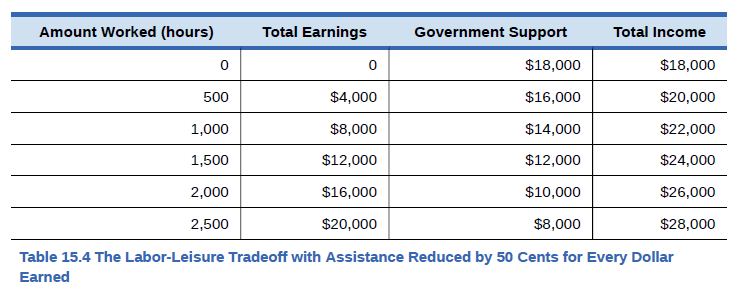
Jonathan is a single father with one child. He can work as a server for $6 per hour for up to

Trending nowThis is a popular solution!

Chapter 15 Solutions
PRINCIPLES OF MICROECONOMICS (OER)
Additional Business Textbook Solutions
Cost Accounting (15th Edition)
Managerial Accounting (4th Edition)
Horngren's Accounting (11th Edition)
Construction Accounting And Financial Management (4th Edition)
Horngren's Cost Accounting: A Managerial Emphasis (16th Edition)
Principles of Management
- Jana has the opportunity to buy the boat of her dreams but needs to determine the best way to fund the purchase. The cost of the boat is $22,000, and she’s considering taking on a second job at which she can earn this amount or selling some investments to generate the cash. However, she realizes that she will also have to pay taxes on any amount she receives. If Jana is in the 35 percent marginal tax bracket and earns $22,000 from a second job, by how much will her end-of-year tax liability increase? What if she elects to sell some investments that she’s held for several years at a gain of $22,000? How would your answer change if she had held the investments for just 6 months?arrow_forwardSuppose that the government introduces an EITC such that for the first $8,000 in earnings, the government pays 50¢ per dollar on wages earned. For the next $3,000 of earnings, the credit is held constant at $4,000, and after that point, the credit is reduced at a rate of 20¢ per dollar earned. When the credit reaches zero, there is no additional EITC. Furthermore assume a worker who can work up to 4,000 hours per year at an hourly wage of $10 per hour. 1. The benefit of EITC will disappear at how many hours of leisure? (use just numbers) 2. When the EITC disappears how much does the worker get to consume (do not use $ sign)arrow_forward1.3 A mandatory health insurance plan costs $4,000. One worker earns $24,500 in employment income and $500 in investment income. Another worker earns $48,000 in employment income and $2,000 in investment income. A third worker earns $68,000 in employment income and $7,000 in investment income. A premium-based system would cost each worker $4,000. A wage tax–based system would cost each worker 8.5 percent of wages. An income tax–based system would cost each worker 8 percent of income. For each worker, calculate the cost of the insurance as a share of total income. E = Employment income I = Investment income P = Premium cost of insurance Premium as a percentage of income = P/(E + I) W = Wage tax cost of insurance = 0.085 × E Wage tax cost as a percentage of income = W/(E + I) T = Income tax cost of insurance = 0.080 × (E + I) Income tax cost as a percentage of income = T/(E + I) 1.4 Which of the plans in exercise 1.3 would impose the larger burden on those with incomes under $25,000: a…arrow_forward
- A mandatory health insurance plan costs $4,000. One worker earns $24,000 in employment income and $500 in investment income. Another worker earns $48,000 in employment income and $2,000 in investment income. A third worker earns $68,000 in employment income and $7,000 in investment income. A premium-based system would cost each worker $4,000. A wage tax-based system would cost each worker 8.5 percent of wages. An income tax-based system would cost each worker 8 percent of income. For each worker, calculate the cost of the insurance as a share of total income.arrow_forwardAssume that workers whoses are less than $8000 currently pay no federal income taxes. Suppose a new government program guarantees each worker $4000, whether or not he or she earns any income. For all earned income up to $8000, the worker must pay a 50- percent tax. Draw the budget line facing the worker under this new program. Using the line drawing tool, draw the new budget line facing a worker whose wage is such that his or her pre-tax earned income is less than $8000. Label this line 'BC2'.arrow_forwardPlease write a different answer there is an answer available for this on Bartleby already and tutors are copying and pasting that answer. but I need a new working from you 1. Consider an individual aged 64 who is eligible to collect full social security (public pension) benefits of $6,000 for a year. They have no other income but can work at a weekly wage rate of $600 for a maximum of 52 weeks. Receipt of benefits from the social security program is retirement tested. Specifically, the individual can earn up to $9,000 in annual wage income without a reduction in benefits; however, after $9,000 of earnings, benefits are reduced by 50% for every dollar earned, until the benefits are exhausted. a) Carefully draw and label the budget constraint for this individual. b) Suppose previously there was a retirement test, and then the test is eliminated, i.e., the individual now is allowed to keep all benefits, irrespective of their labour earnings. How would this affect the individual's…arrow_forward
- Suppose that country B has a population of 5,000 households and a poverty line of $15,000. 4,000 households have expenditure levels of $10,000, below the poverty line of $15,000, while the remainder of households have expenditures above the poverty line. What is the poverty headcount ratio for this country?arrow_forwardConsider a person who can work up to 80 hours each week at a pretax wage of $20 per hour but faces a constant 20 percent payroll tax. Under these conditions, the worker maximizes her utility by choosing to work 50 hours each week. The government proposes a negative income tax whereby everyone is given $300 each week and anyone can supplement her income further by working. To pay for the negative income tax, the payroll tax rate will be increased to 50 percent.a. On a single graph, draw the worker’s original budget line and her budget line under the negative income tax.b. Show that the worker will choose to work fewer hours if the negative income tax is a dopted.c. Will the worker’s utility be greater under the negative income tax?arrow_forwardConsider an individual aged 64 who is eligible to collect full social security (public pension) benefits of $6000 for a year. She has no other income, but can work at a weekly wage rate of $600 for a maximum of 52 weeks. Receipt of benefits from the social security program is retirement-tested. Specif- ically, the individual can earn up to $9000 in annual wage income without a reduction in benefits; how- ever, after $9000 of earnings, benefits are reduced by 50 percent for every dollar earned, until the ben- efits are exhausted. a. Carefully draw and label the budget constraint for this individual. b. Consider an individual whose labour supply decision is such that she receives YA in social security benefits, so that 0 , YA , $6000 (i.e., she receives positive but reduced benefits). On the carefully labelled diagram from part (a), show her labour supply decision. c. “Elimination of the retirement test (i.e., allowing the individual to keep all benefits, irrespective of his or her…arrow_forward
- The Environmental Protection Agency (EPA) wants to investigate the value workers place on being able to work in “clean” mines over “dirty” mines. The EPA conductsa study and finds the average annual wage in clean mines to be $42,250 and the average annual wage in dirty mines to be $47,250.a. According to the EPA, how much does the average worker value working in a clean mine?b. Suppose the EPA could mandate that all dirty mines become clean mines and that all workers who were in a dirty mine must therefore accept a $5,000 pay decrease. Are these workers helped by the intervention, hurt by the intervention, or i ndifferent to the intervention?arrow_forwardThe FGT0 measure does not reflect the depth of poverty below the poverty line. [6] (i) Suggest a specific income transfer within this economy that demonstrates this limitation of FGT0. Take $1 from person 2 and give it to person 4. This makes person 2 poorer in absolute terms, but does not change FGT0. (ii) Compute FGT0 after the transfer. Still 3/6. (iii)Discuss why this feature limits how useful FGT0 is as a measure of poverty. FGT0 is not able to capture changes among the poor. For example, the desperately poor could become much better off and, as long as they weren’t so much better off that they cross the poverty line, we would see no improvement in poverty as measured by FGT0.arrow_forward
 Principles of Economics 2eEconomicsISBN:9781947172364Author:Steven A. Greenlaw; David ShapiroPublisher:OpenStax
Principles of Economics 2eEconomicsISBN:9781947172364Author:Steven A. Greenlaw; David ShapiroPublisher:OpenStax Economics: Private and Public Choice (MindTap Cou...EconomicsISBN:9781305506725Author:James D. Gwartney, Richard L. Stroup, Russell S. Sobel, David A. MacphersonPublisher:Cengage Learning
Economics: Private and Public Choice (MindTap Cou...EconomicsISBN:9781305506725Author:James D. Gwartney, Richard L. Stroup, Russell S. Sobel, David A. MacphersonPublisher:Cengage Learning Microeconomics: Private and Public Choice (MindTa...EconomicsISBN:9781305506893Author:James D. Gwartney, Richard L. Stroup, Russell S. Sobel, David A. MacphersonPublisher:Cengage Learning
Microeconomics: Private and Public Choice (MindTa...EconomicsISBN:9781305506893Author:James D. Gwartney, Richard L. Stroup, Russell S. Sobel, David A. MacphersonPublisher:Cengage Learning

 Survey of Economics (MindTap Course List)EconomicsISBN:9781305260948Author:Irvin B. TuckerPublisher:Cengage Learning
Survey of Economics (MindTap Course List)EconomicsISBN:9781305260948Author:Irvin B. TuckerPublisher:Cengage Learning





